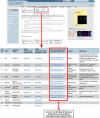The GUDMAP database--an online resource for genitourinary research
- PMID: 21652655
- PMCID: PMC3188593
- DOI: 10.1242/dev.063594
The GUDMAP database--an online resource for genitourinary research
Abstract
The GenitoUrinary Development Molecular Anatomy Project (GUDMAP) is an international consortium working to generate gene expression data and transgenic mice. GUDMAP includes data from large-scale in situ hybridisation screens (wholemount and section) and microarray gene expression data of microdissected, laser-captured and FACS-sorted components of the developing mouse genitourinary (GU) system. These expression data are annotated using a high-resolution anatomy ontology specific to the developing murine GU system. GUDMAP data are freely accessible at www.gudmap.org via easy-to-use interfaces. This curated, high-resolution dataset serves as a powerful resource for biologists, clinicians and bioinformaticians interested in the developing urogenital system. This paper gives examples of how the data have been used to address problems in developmental biology and provides a primer for those wishing to use the database in their own research.
Figures






References
-
- Baldock R. A., Bard J. B., Burger A., Burton N., Christiansen J., Feng G., Hill B., Houghton D., Kaufman M., Rao J., et al. (2003). EMAP and EMAGE: a framework for understanding spatially organized data. Neuroinformatics 1, 309-325 - PubMed
-
- Bard J. L., Kaufman M. H., Dubreuil C., Brune R. M., Burger A., Baldock R. A., Davidson D. R. (1998). An internet-accessible database of mouse developmental anatomy based on a systematic nomenclature. Mech. Dev. 74, 111-120 - PubMed
Publication types
MeSH terms
Grants and funding
LinkOut - more resources
Full Text Sources
Other Literature Sources
Molecular Biology Databases

